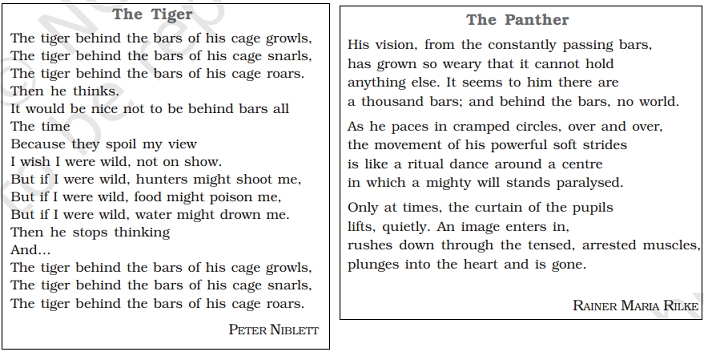NCERT English - Class 10
First Flight (Poem)
Chapter 2: A Tiger in the Zoo
Thinking about the Poem
Question: 1
Read the poem again and work in pairs or groups to do the following tasks.
- Find the words that describe the movements and actions of the tiger in the cage and in the wild. Arrange them in two columns.
- Find the words that describe the two places and arrange them in two columns.
Now try to share ideas about how the poet uses words and images to contrast the two situations.
Answer i:| In the Cage | In the Wild |
|---|---|
| Stalks, Few steps of his cage, Quiet rage Locked in concrete cell, Stalking-the length of his cage Ignoring visitors. He hears the last voice Stares at the brilliant stars. | Lurking in shadow, Sliding through long grass, Snarling around houses, Baring his white fangs, his claws, Terrorising the village. |
Answer ii:
| Cage | Wild |
|---|---|
| Few steps of his cage, | Shadow, Long grass, Water |
| Locked, Concrete cell, | hole, Plump deer, |
| Behind bars, Visitors, | Houses at jungle’s edge, |
| Patrolling cars | Village |
Question: 2
Notice the use of a word repeated in lines such as these
- On pads of velvet quiet, In his quiet rage.
- And stares with his brilliant eyes At the brilliant stars.
What do you think is the effect of this repetition?
Answer:This repetition is a poetic device used by the poet in order to increase the intensity of the tiger’s rage and his helpless silence. ‘Velvet quiet’ refers to the quiet velvet pads of the tiger, which cannot run or leap. They can only walk around the limited space in the cage. The use of ‘quiet rage’ symbolises the anger and ferocity that is building up inside the tiger as it wants to run out into the forest and attack a deer, but the rage is quiet because he is locked in the cage and is helpless. The repetition of ‘quiet’ has, thus, brought immense beauty to the poem. Similarly, the use of ‘brilliant’ for the tiger’s eyes as well as the stars also brings out the magnificence of these lines. The tiger stares at the brilliant stars with his brilliant eyes dreaming about how beautiful his life could be in the forest. The repetition thus, gives a wonderful effect to the poem.
Question: 3
Read the following two poems one about a tiger and the other about a panther. Then discuss:
Are zoos necessary for the protection or conservation of some species of animals?
Are they useful for educating the public?
Are there alternatives to zoos?

Answer:
Several species of animals are on the verge of extinction.
Even tigers and lions are not safe in the forest due to poaching that is done for trade, etc. Zoos are, thus, necessary for the protection or conservation of these species. Zoos are safe and can also be used to educate the public about the importance of wild animals and their role in maintaining the ecological balance. Wildlife sanctuaries, reserves and national parks are some alternatives to zoos. These not only help in the protection and conservation of these species, but also provide them with a natural habitat.